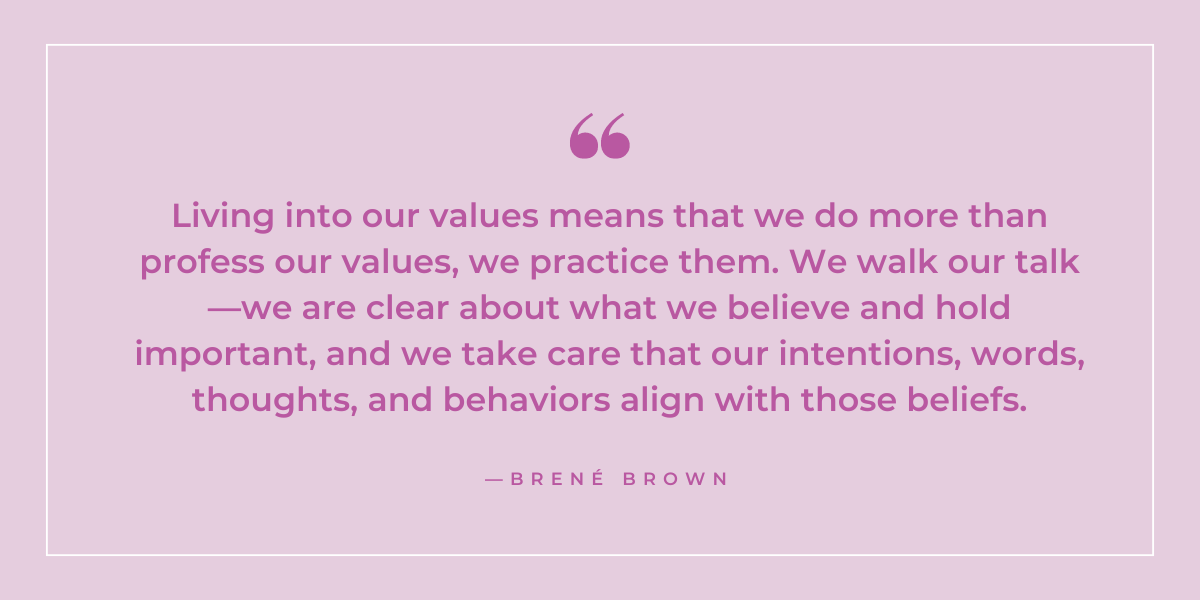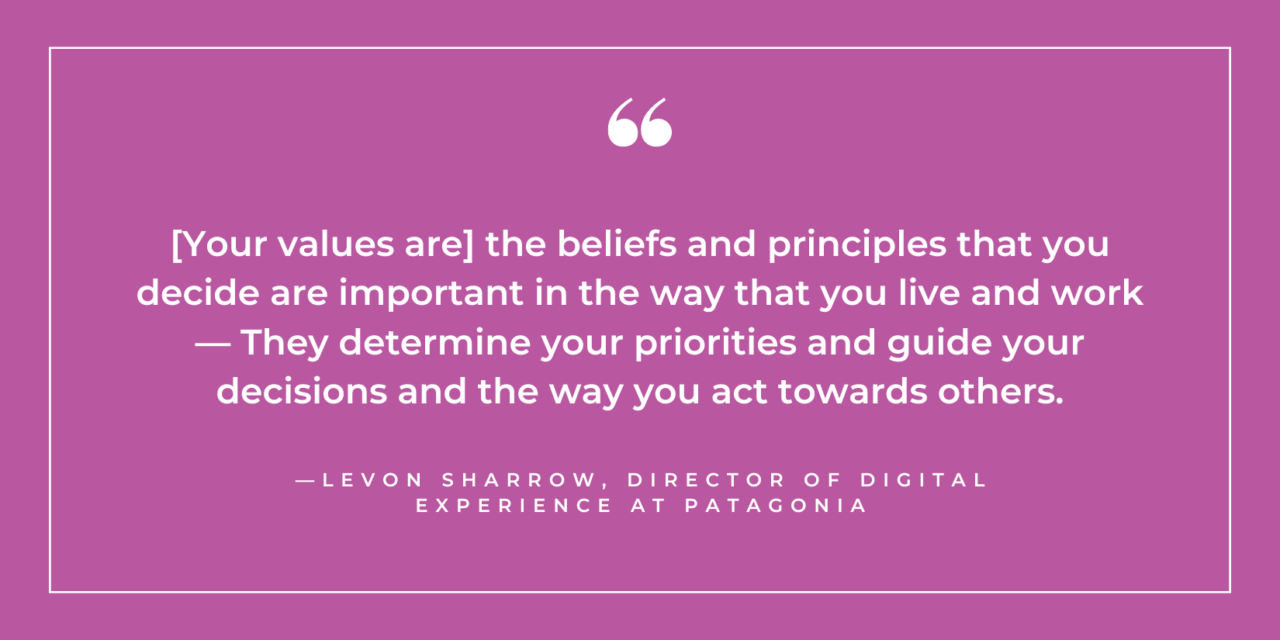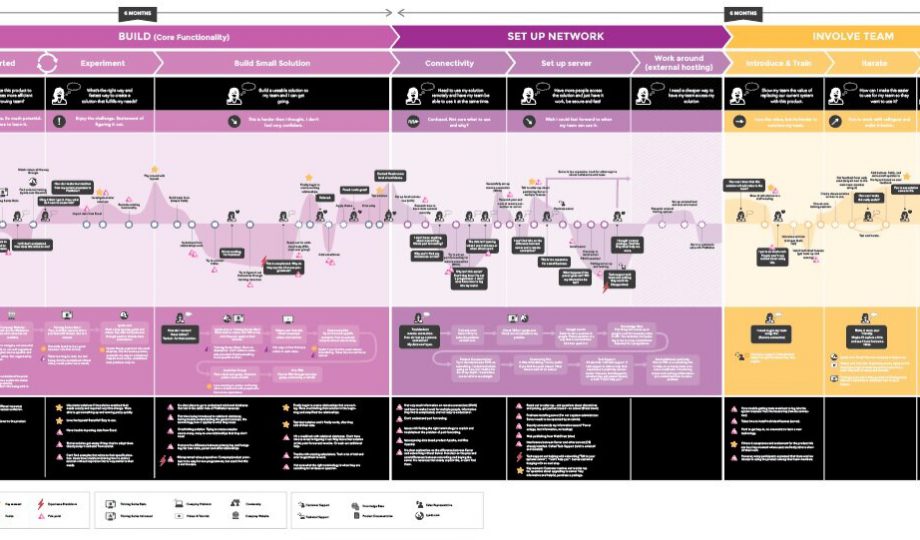We’ve hit a hectic period of change, not just in the world of UX design and service design, but the entire tech space. But whether we’re facing an economic downturn or unpredictable factors based on evolving technology, values-driven companies are starting to gain a competitive edge.
A deep understanding of our own values and how they relate to others is a key component of leading successful teams in the UX space while avoiding common growing pains. That’s why today’s blog will be focused on values-based approach in the context of design leadership, UX leadership and business leadership in general! We’ll cover:
- The definition of values-based leadership
- Its importance
- How it relates to human-centered design
- How to demonstrate values-based leadership in UX and service design contexts
What is Values-Based Leadership?
Also called “value-driven leadership,” values-based leadership is a leadership style that involves getting to know our own values as leaders through self-reflection and finding ways to lead from those values. It also involves aligning our values with those of an organization and its people so that we can foster trusting, productive and high-performing teams.
Leadership based on a values system is an increasingly popular concept in conversations about management. A lot of different leadership theories have emerged over the last few decades. This one comes on the heels of a shift from servant-based leadership (which focuses on a leader’s ability to serve their team) to authentic leadership (which focuses on the leader’s transparency, accountability and integrity).
Values-based leadership is very similar to authentic leadership — both are rooted in a mindfulness about one’s values. We see values-based leadership as a more specific branch of this theory that’s based on the practice of self-reflection and self-awareness.
View this post on Instagram
The Importance of Values-Based Leadership
A values-driven approach in leadership is important because it will help you ensure that you’re always coming from an authentic place that reflects the current version of you and all the circumstances around you. This is crucial in project management, design strategy and arguably, business strategy as a whole.
It can sometimes feel like there’s no time left to think, and we can start to be less conscious about how we lead. But, at the end of the day, we are humans, and so are our stakeholders and teams. We need to understand each other on a deeper level to work together effectively (and to want to keep working together!).
Here are some other major reasons why you should consider a values-based approach, or revisit your values if it’s been a while:
- The context (and you) will always shift. Maybe you’ve done some work examining your values before, but time flew by, and suddenly, that feels like a long time ago. Most people and most teams will evolve, which means the values we’re working with can shift, too.
- Leaders need to understand themselves. In design leadership, it’s important to understand our own values and work with them to navigate hard situations and with peace of mind. People often talk about employee satisfaction, but it’s hard to make others happy if we’re not “feeling it” ourselves.
- Authentic leadership = effective leadership. A lack of connection with a leader can be easily felt — people are good at reading each other. In the same vein, directives and encouragement coming from a place of authenticity can be more easily heard and taken to heart.
- Leadership should be aspirational. Being a leader comes with some pain points, no matter what your values are. But if you work with people you want to promote one day, it’s important to model what healthy, happy leadership looks like. That’s a lot easier to do when it’s genuine.
- Everyone answers to someone. Whether you’re a CEO or a junior designer, chances are, you’ve seen periods of time where you or your decisions have been beholden to somebody else. (If you don’t have a direct supervisor, then it might be clients, board members, shareholders and/or investors).
Effective leaders who are “beholden” in some way will tap into their values to help them decide when to push back, when to bend and how to frame big or unfavourable changes to teams without causing stress or affecting morale.
How to Demonstrate Values-Based Leadership in UX and Service Design
We Outwitlians got the inspiration for this blog post from a recent team visit to the Design Leadership Summit put on by DesignX Community Inc. There were a number of inspiring talks about different approaches and principles for demonstrating authentic leadership and values-based leadership.
We’ve summarized a few of these approaches from the conference below and a couple of other approaches our team has encountered, so you can read about them all in one place!
1. Applying four key values-based principles
Harry Kraemer, a professor at the Kellogg School of Management, is known for writing a book about values-based leadership. He teaches there are four key principles to this style of leadership:
-
- Self-reflection: This is defined as an ongoing process of self-understanding and not a cocooning period. We should reflect on not only what we value most, but also what we do well and areas for improvement.
- Balanced perspective: We should consider all sides of a situation and listen well to team members; we should also strive for “life balance” and give due attention to the other pillars of our lives outside of work. This will help us come from a stable foundation.
- True self-confidence: This means admitting when we don’t know something or are unsure what to do. Authentic values-based leadership means focusing on problem-solving and resisting defensiveness.
- Genuine humility: As leaders we should remember “where we came from” and allow that perspective to colour the way that we approach leadership now.
2. Homing in on your values
Famous social worker and vulnerability researcher, Brené Brown, has a great tool for taking stock of a person’s values: a list of values to draw from. It can be hard to think up your values on your own, but looking at a list can help narrow it down. (You’re meant to choose 2-3, which can be hard to do!) We’ve done this exercise with our team members already, and we added in some key values that came up in our discussion:
-
- Fun
- Making a Difference
- Reliability
- Humour
- Resourcefulness
- Time
Feel free to use Brené Brown’s version or modify it and make your own based on your specific organization.
3. Reframing the question as needed
Having trouble defining your values or narrowing them down? A panel discussion we especially enjoyed at the Design Leadership Summit (DLS 2024) offered a few ways to reframe the question that might help. (Credit to the Unseen Lives of Design Leaders discussion, with Katrina Alcorn, Levon Sharrow and Christina Goldschmidt, moderated by Bob Baxley.) Leaders who might struggle with meaningful introspection are encouraged to visualize and think about things a bit more metaphorically, in terms of what kind of energy and light they let into their working lives.
Some helpful questions to ask as you do this:
-
- What do I let in?
- Who do I let in?
- When do I feel at my best?
We love this way of getting into a retrospective mindset. After all, retrospection is key in UX and service design processes.
4. Sharing your values with others
Levon Sharrow, the Director of Digital Experience at Patagonia, also spoke at the DLS 2024 conference. He emphasized that we should focus on not just self-reflection, but putting our values into action.
After defining your values, he laid out the following steps, which might seem obvious to some, but are overlooked surprisingly often:
-
- Talk about your values: We should share our values with our team(s) and prompt them to do the same exercise and communicate their values. (The Outwitly team recently did this; it was a great bonding experience! It also helped everyone understand each other, what each of us needs and why we work the way we do.)
- Exercise your values: We should incorporate daily reminders of our values, so that when we need to make decisions and start initiatives, we align them with what truly matters to us, our team and our organization.
5. Levering superpowers and coaching for blind spots
A Design Leadership Fundamentals Masterclass from the DLS 2024 conference focused on actions you can take once you’ve recognized your values, strengths and weak spots:
-
- Leverage your superpowers: Your values usually coincide with some of your biggest strengths. Making this connection can help embrace your values on a deeper level and push yourself to greater heights. This can be applied not to just yourself, but to everybody that you’re leading. You can help them find their superpowers through self-reflection, too.
- Coach for blind spots: Once you’ve pinpointed areas for improvement, develop some strategies for how your superpowers could mitigate them. This is also great for coaching teams. It’s important to understand their pain points, just like you would with users or customers. You could even facilitate a workshop around this!
(Credit to the two DLS 2024 speakers for this one: Daniela Jorge, Chief Design Officer (CDO) at Capital One and Kaaren Hanson, CDO at JP Morgan Chase & Co.)
Whether you follow one or all of these approaches and principles, we’re confident that it will help you weather more storms, attract UX unicorns to your teams and keep/motivate the amazing people you already work with.
Comparing Values-Based Leadership and Human-Centered Design
In UX and service design, we often discuss human-centered design (HCD) and how a human-centered approach is crucial to innovation. When it comes to leading teams, we would argue that a values-based leadership approach is just as important as a human-centered approach in design.
In fact, we see these as two sides of the same coin: values-based leadership is a human-centered way of looking at leadership. They involve approaching things from a human perspective.
Below, we’ve outlined 3 key ways that values-based leadership can apply to design leadership and UX leadership in an HCD context.
Both HCD and values-based leadership focus on the following:
1. Leveraging emotional intelligence
Think about how important empathy is in all aspects of human-centered design: We need it to glean in-depth information and perspectives from design research participants, and we need it to imagine solutions for organizations, customers and users. The same can be said about leadership. It’s hard to be effective in providing motivation, giving performance feedback or emphasizing priorities when we’re not reading the room or creating safe spaces for our teams.
2. Prioritizing alignment
Alignment is crucial in design leadership: alignment with project goals, team goals, stakeholder needs, user needs, task priorities, etc. With values-driven leadership, it’s equally important to align your values with your decisions, teams and mission statement is equally important. Once you’ve aligned your values, it will be easier to find mutual understanding, brainstorm together and find common ground that motivates and inspires not only your team but yourself, too.
3. Divergent and convergent thinking
With human-centered design, we’re designing based on a set of insights from research with real users. But to get those insights, we need to analyze and synthesize our research data, which requires an intense level of reflection. Then, we need to narrow in on the most common pains, needs, behaviours and takeaways in order to deliver approachable, actionable insights.
In some ways, this process is parallel to the self-reflection process in values-based leadership. To understand our values and express them to others, we first have to step back and give some deep thought to all of the recent events, actions and information we’ve processed in our day-to-day. Then, we can narrow in on values-driven decision-making.
Key Takeaways for Value-Based Leadership in Design
We hope that today’s post created a helpful starting point or refresher for your exploration of values-based leadership. Here are some key takeaways from the above:
- Values-based leadership is a way of bringing authenticity to your everyday operations as a leader by increasing and improving your self awareness.
- Examining your values shouldn’t be done in a vacuum — you should also consider and discuss the values of those you lead and those who lead you.
- The human-centered approach to design and the values-based approach to leadership share a lot of similarities, so it’s no coincidence that this approach is very effective in design leadership.
With the daily craziness that most leaders face, we get that this all can seem “easier said than done.” But no matter how hectic things are, we hope you’ll feel inspired to take a step back and prioritize a highly conscious and collaborative values-based approach.







